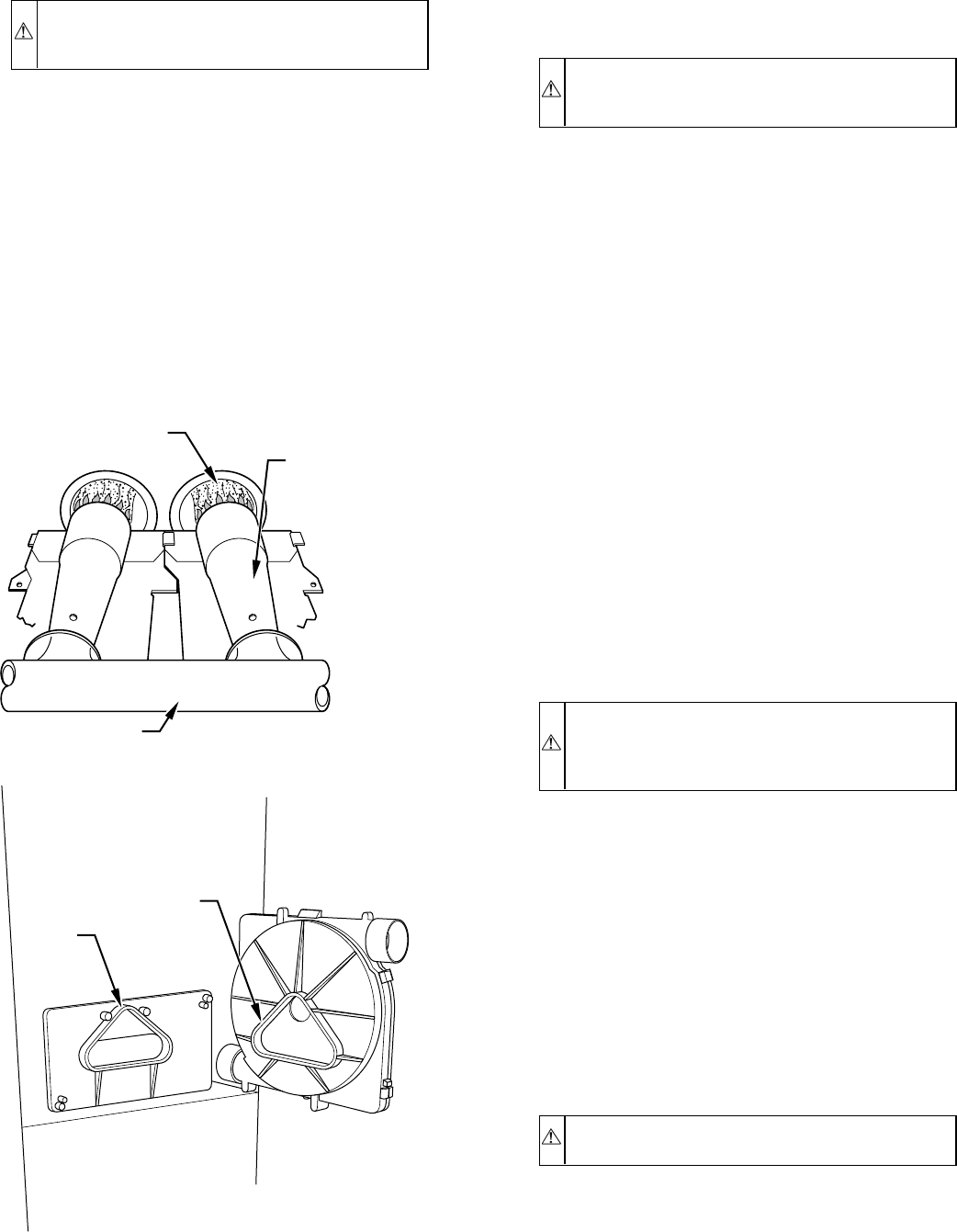
box or inlet pipe, but can be removed without removing
either. After removing screw, slide igniter and bracket
toward outside of burner box and pull straight out.
CAUTION: The igniter is fragile. DO NOT allow it to
hit the side of the burner box opening while removing or
replacing it.
b. Inspect igniter for a white area indicating a crack may be
present. If found, replace igniter.
NOTE: A small crack cannot be seen on a new igniter. After a
period of operation, a white area will be visible around the crack.
c. If replacement is required, replace igniter on igniter
bracket external to furnace to avoid damage as the
silicon portion is very brittle and will easily crack or
shatter.
d. To remove igniter from igniter bracket, remove screw
holding igniter ceramic block to bracket and pull ce-
ramic block out of bracket.
6. To replace igniter/igniter assembly, reverse items 5a
through 5d.
7. Reconnect igniter wire connection.
8. Turn on gas and electrical supplies to furnace.
9. Verify igniter operation by initiating furnace control self-
test feature or by cycling thermostat.
10. Replace main furnace door.
VII. ELECTRICAL CONTROLS AND WIRING
CAUTION: There may be more than 1 electrical supply
to the unit. Check accessories and cooling unit for
additional electrical supplies.
The electrical ground and polarity for 115-v wiring must be
maintained properly. Refer to Fig. 11 for field wiring information
and to Fig. 15 for unit wiring information.
NOTE: If the polarity is not correct, the STATUS LED on the
furnace control will flash rapidly and prevent the furnace from
operating. The control system also requires an earth ground for
proper operation of the furnace control and flame sensor.
The 24-v circuit contains an automotive-type, 3-amp fuse located
on the control center. (See Fig. 11.) Any direct shorts of the 24-v
wiring during installation, service, or maintenance will cause this
fuse to blow. If fuse replacement is required, use ONLY a fuse of
identical size (3 amp). The control LED will flash status code 24
when fuse needs to be replaced.
With power to the unit disconnected, check all electrical connec-
tions for tightness. Tighten all screws on electrical connections. If
any smoky or burned connections are found, disassemble the
connection, clean all parts, strip wire, and reassemble properly and
securely.
Reconnect electrical supply to unit and observe unit through 1
complete operating cycle for proper operation.
VIII. CHECKING HEAT TAPE OPERATION
(IF APPLICABLE)
In applications where the ambient temperature around the furnace
is 32°F or lower, freeze protection measures are required. If heat
tape has been applied, check to ensure it will operate when low
temperatures are present.
CAUTION: If this furnace is to be operated in an
unconditioned space where the ambient temperatures may
be 32°F or lower, freeze protection measures must be
taken. (See Fig. 13.)
NOTE: See CONDENSATE DRAIN PROTECTION section of
Installation, Start-Up, and Operating Instructions.
NOTE: Heat tape, when used, should be wrapped around the
condensate drain trap and drain line. There is no need to use heat
tape within the furnace casing. Most heat tapes are temperature
activated, and it is not practical to verify the actual heating of the
tape. Check the following:
1. Check for signs of physical damage to heat tape such as
nicks, cuts, abrasions, gnawing by animals, etc.
2. Check for discolored heat tape insulation. If any damage or
discolored insulation is evident, replace heat tape.
3. Check that heat tape power supply circuit is on.
IX. WINTERIZING
CAUTION: Freezing condensate left in the furnace will
damage the equipment.
If the furnace will be off for an extended period of time in a
structure where the temperature will drop to 32° or below,
winterize as follows:
BURNER FLAME
BURNER
MANIFOLD
A89020
Fig. 9—Burner Flame
RTV
PAM
A93081
Fig. 10—Gasket on Collector Box
—8—
